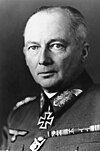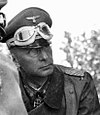|
Army Group Centre
Army Group Centre (German: Heeresgruppe Mitte) was the name of two distinct strategic German Army Groups that fought on the Eastern Front in World War II. The first Army Group Centre was created during the planning of Operation Barbarossa, Germany's invasion of the Soviet Union, as one of the three German Army formations assigned to the invasion. After Army Group North was trapped in the Courland Pocket in mid-1944, it was renamed to Army Group Courland and the first Army Group Centre was renamed "Army Group North". The second iteration of Army Group Centre was formed by the redesignation of Army Group A as the replacement for the first Army Group Centre. Formation and CommandThe army group was officially created by Adolf Hitler when he issued Führer Directive 21[1] on 18 December 1940, ordering German forces to prepare for an attack on Soviet Russia in 1941. The first commanding officer of Army Group Centre was Field Marshal Fedor von Bock, who would lead it until he was relieved on 18 December 1941 after the failure of the Battle of Moscow and was replaced by Field Marshal Günther von Kluge. Günther von Kluge would remain the army group's commander until he was injured in October 1943 and replaced by Field Marshal Ernst Busch, who would then be replaced by Field Marshal Walter Model in June 1944. When Model was transferred to the Western Front in August 1944, he was replaced by Ferdinand Schörner, who would command the army group until his desertion in May 1945 after Germany surrendered to the Allies. Order of battle at formationCampaign and operational historyOperation BarbarossaOn 22 June 1941, Nazi Germany and its Axis allies launched their surprise offensive into the Soviet Union. Their armies, totaling over three million men, were to advance in three geographical directions. Army Group Centre's initial strategic goal was to defeat the Soviet armies in Belarus and occupy Smolensk. To accomplish this, the army group planned for a rapid advance using Blitzkrieg operational methods for which purpose it commanded two panzer groups rather than one. A quick and decisive victory over the Soviet Union was expected by mid-November. The Army Group's other operational missions were to support the army groups on its northern and southern flanks, the army group boundary for the later being the Pripyat River.
Bitter fighting in the Battle of Smolensk as well as the Lötzen decision delayed the German advance for two months. The advance of Army Group Centre was further delayed as Hitler ordered a postponement of the offensive against Moscow in order to conquer Ukraine first. Attack on Moscow
The commander in chief as of 19 December 1941 was Günther von Kluge (for a short time before Christmas of 1941, this role was fulfilled by Günther Blumentritt). Rzhev operations1942 opened for Army Group Centre with continuing attacks from Soviet forces around Rzhev. The German Ninth Army was able to repel these attacks and stabilise its front, despite continuing large-scale partisan activity in its rear areas. Meanwhile, the German strategic focus on the Eastern Front shifted to southwestern Russia, with the launching of Operation Blue in June. This operation, aimed at the oilfields in the southwestern Caucasus, involved Army Group South alone, with the other German army groups giving up troops and equipment for the offensive. Despite the focus on the south, Army Group Centre continued to see fierce fighting throughout the year. While the Soviet attacks in early 1942 had not driven the Germans back, they had resulted in several Red Army units being trapped behind German lines. Eliminating the pockets took until July, the same month in which the Soviets made another attempt to break through the army group's front; the attempt failed, but the front line was pushed back closer to Rzhev. The largest Soviet operation in the army group's sector that year, Operation Mars, took place in November. It was launched concurrently with Operation Uranus, the counteroffensive against the German assault on Stalingrad. The operation was repulsed with very heavy Soviet losses, although it did have the effect of pinning down German units that could have been sent to the fighting around Stalingrad.
Campaign in central RussiaFollowing the disaster of Stalingrad and poor results of the Voronezh defensive operations, the army high command expected another attack on Army Group Centre in early 1943. However, Hitler had decided to strike first. Before this strike could be launched, Operation Büffel was launched to forestall any possible Soviet spring offensives, by evacuating the Rzhev Salient to shorten the frontline.
The commander in chief as of 12 October 1943 was Ernst Busch.
Belarusian anti-partisan campaignThe following major anti-partisan operations were conducted in the rear of Army Group Centre, alongside many smaller operations:
Increasing coordination of the partisan activity resulted in the conducting of Operation Concert against the German forces. Operation Citadel
Wotan Line defensive campaign
Destruction of Army Group CentreIn the spring of 1944, the Soviet High Command started concentrating forces along the front line in central Russia for a summer offensive against Army Group Centre. The Red Army also carried out a deception campaign to convince the Wehrmacht that the main Soviet summer offensive would be launched further south, against Army Group North Ukraine. The German High Command was fooled and armored units were moved south out of Army Group Centre. The Soviet offensive, code-named Operation Bagration, was launched on 22 June 1944, the third anniversary of Germany's own invasion of the Soviet Union, Operation Barbarossa. 185 Red Army divisions, comprising 2.3 million soldiers and 4,000 tanks and assault guns, smashed into the German positions on a 200km-wide front. The 850,000-strong Army Group Centre was almost completely destroyed by the attack. It is estimated that over 450,000 Germans were killed, wounded, or captured, notably the 57,000 soldiers captured east of Minsk, who were paraded through Moscow on 17 July on Stalin's orders as proof of the immense success of the Soviet offensive. The Soviet forces raced forward, liberating Minsk and the rest of Belorussia by mid-July, and reaching the Vistula and the Baltic States by early August. In terms of casualties this was the greatest German defeat of the entire war. The commander in chief of Army Group Centre as of 28 June 1944 was Walter Model.
The commander in chief as of 16 August 1944 was Georg Hans Reinhardt.
Defensive campaign in Poland and SlovakiaDiscussion of the army group's situation in January 1945 should note that the army groups in the east changed names later that month. The force known as "Army Group Centre" at the start of the Soviet Vistula-Oder Offensive on 12 January 1945 was renamed "Army Group North" less than two weeks after the offensive commenced. At the start of the Vistula-Oder Offensive, the Soviet forces facing Army Group Centre outnumbered the Germans on average by 2:1 in troops, 3:1 in artillery, and 5.5:1 in tanks and self-propelled artillery.[3] The Soviet superiority in troop strength grows to almost 3:1 if 200,000 Volkssturm militia are not included in German personnel strength totals. Defence of the Reich campaignOn 25 January 1945, Hitler renamed three army groups. Army Group North became Army Group Courland, Army Group Centre became Army Group North, and Army Group A became Army Group Centre. Army Group Centre fought in the defence of Slovakia and Bohemia-Moravia as well as sections of the German heartland. Between January and February 1945, Army Group Centre sustained 140,000 casualties, including 15,000 dead, 77,000 wounded (not counting non-evacuees), and 48,000 missing.[4]: 559 Battle of BerlinThe last Soviet campaign of the war in the European theater, which led to the fall of Berlin and the end of the war in Europe with the surrender of all German forces to the Allies. The three Soviet Fronts involved in the campaign had altogether 2.5 million men, 6,250 tanks, 7,500 aircraft, 41,600 artillery pieces and mortars, 3,255 truck-mounted Katyusha rocket launchers (nicknamed "Stalin Organs" by the Germans), and 95,383 motor vehicles. The campaign started with the battle of Oder-Neisse. Army Group Centre commanded by Ferdinand Schörner (the commander in chief as of 17 January 1945) had a front that included the river Neisse. Before dawn on the morning of 16 April 1945 the 1st Ukrainian Front under the command of General Konev started the attack over the river Neisse with a short but massive bombardment by tens of thousands of artillery pieces.
Battle of PragueSome of the Army Group Centre continued to resist until 11 May 1945, by which time the overwhelming force of the Soviet Armies sent to liberate Czechoslovakia in the Prague Offensive gave them no option but to surrender or be killed.
SurrenderBy 7 May 1945, the day that German Chief-of-Staff General Alfred Jodl was negotiating surrender of all German forces at SHAEF, the German Armed Forces High Command (AFHC) had not heard from Schörner since 2 May 1945. He had reported that he intended to fight his way west and surrender his army group to the Americans. On 8 May 1945, a colonel from the Allied Forces High Command was escorted through the American lines to see Schörner. The colonel reported that Schörner had ordered the men under his operational command to observe the surrender but that he could not guarantee that he would be obeyed everywhere. Later that day, Schörner deserted his command and flew to Austria where on 18 May 1945 he was arrested by the Americans. Commanders
See alsoNotes and references
Bibliography
Further reading
|
||||||||||||||||||||||||||||||||||||||||||||||||||||||||||





